Whether you’re an athlete or you’d just like to take a walk without pain, a clear path to moving better begins at the hips.
“The hips are an avenue toward more movement freedom, and life is always better when we have more of that,” says strength coach Kate Galliett, BS, FRCms, NASM-CES, founder of The Unbreakable Body program.
As the junction point between the top and bottom halves of the body, the hips play a key role in our movement, overall health, and quality of life.
At the same time, we’ve been led to believe that these ball-and-socket joints will eventually wear out and that we’re destined for hip pain, immobility, or even surgery. (For more on hip replacements, see “Get Hip”.)
But even if you’re currently dealing with hip dysfunction, or you’ve already replaced the joint, it’s not too late to turn things around. By paying more attention to the health of your hips, you can rehab from common health complaints that many of us assume are an inevitable part of aging — or prehab to prevent them in the first place. As a result, you’ll be able to move better.
Our experts provide an overview of the hips: how they work, what they do, and common issues that may crop up when time and our lifestyles take their toll. These recommended strategies can help keep your hips healthy, mobile, and pain-free for years to come.
Hip to Your Hips
When your hips are working optimally and are in sync with the rest of the kinetic chain, the effect is movement that feels more effortless and free.
This is something that many of us enjoyed as children, and fewer of us experience as adults. It’s something that goes largely unnoticed, allowing us to move around without thinking much about it — that is, until it’s compromised or gone.
There are many reasons we relinquish optimal hip function (and there are many different symptoms of the dysfunction). Fortunately, we don’t have to lose it for good.
Do you have pain in your hips?
Pain in the inner hips and groin may indicate a problem with the joint itself. Conditions such as arthritis, inflammation of a bursa (known as bursitis), pinched nerves, gynecological issues, hernia, tendinitis, and injuries, such as a fracture or tear, can all cause pain in the hip area, too.
Genetic conditions affecting the thighbone and hip socket can predispose you to hip impingement. Seek medical assistance if you experience pain within the hips — particularly following an acute injury, accident, or other notable event; if the pain is sudden; or if you can’t put weight on your leg or move your leg.
How about pain in your lower-back, knees, ankles, or feet?
There is more to hip dysfunction than hip pain. Weakness and immobility in the hips can affect how your knees, ankles, and feet handle repetitive or explosive movements like walking, running, or jumping, as well as how much extra work your lower back has to do to lift and carry things, says Joslyn.
In fact, knee, foot, and lower-back issues may originate as instability, injury, or other dysfunction in the hips.
Experts say that — short of an acute injury such as a break caused by an accident or fall — hip problems often show up elsewhere for many people. And the first symptom isn’t necessarily pain.
“If we’re having pain or stiffness or weakness in the hip, our bodies can move in abnormal ways to make up for it, which can cause pain, overuse injuries, or muscular imbalances [elsewhere] that just contribute to further injury,” Joslyn adds.
Hip weakness, instability, and immobility can show up in subtle ways, including knees caving in while you’re running or squatting; feet defaulting to a duck-like stance, with toes pointing out, while you’re standing or walking; or hips feeling extremely tight while you’re stretching.
If your hips can’t do what you’re asking them to do, the structures above and below them will adjust to compensate. “Our body will always take the path of least resistance,” Galliett says. “If your hips can’t do something, your body will find another way.”
Is most of your day spent in a sedentary posture?
This includes long bouts of sitting at a desk, on the couch, behind a steering wheel, or in front of a screen. But a sedentary lifestyle can also include monotonous positions in general, involving a lack of frequent shifts in posture or in planes of motion.
Spending a lot of time in one position means our hips don’t get to move in all the ways they’re meant to move, explains Lensing. This causes hip muscles to weaken and tighten, which often leads to pain and injury — especially if you expect your glutes and other muscles to keep up with the demands of your exercise routine.
“What happens is people who have tight hips from sitting all day will try to go for a run and their bodies are like, Whoa, what are you doing to me? I’m not prepared for this!” Lensing says.
Are you pregnant, or have you given birth?
During pregnancy, levels of relaxin (a hormone that causes the structures that make up the pelvic region to relax) increase, and the pelvis widens to accommodate the growing fetus and to prepare for giving birth.
“At that time, you’re also gaining weight, which can have an impact on how those joints are feeling,” Joslyn says.
These changes alter the way you stand and walk, putting extra stress on your hips that may result in pain or other issues up and down the kinetic chain.
These effects can last well beyond the end of pregnancy: Even years later, women may experience hip pain or dysfunction that can be traced back to carrying a baby.
For some, time offers sufficient healing. For many others, postpartum interventions, such as working with a knowledgeable coach or physical therapist, might be necessary.
Remember that no matter how much time has passed since your last pregnancy, it’s never too late to rehabilitate the hips.
Are you getting older?
This is a trick question, since we’re all aging. Time can take a toll on our hip health, especially if we don’t work on it.
The cartilage that cushions the hip joint wears down or becomes damaged over time. Muscles and tendons are overused or underused. A fall or accident can result in a fracture — which can happen anytime in life but is more common (and potentially more problematic) as we age, because of diminishing bone density. One in three women and one in 12 men will fracture a hip in their lifetime, and 86 percent of fractures happen to those age 65 and older.
“We are all ‘wrinkling on the inside,’” says Joslyn. “This is a natural process.” Some things, like degraded cartilage, we cannot change. “However, we can improve the function of our hip joint by strengthening surrounding muscles and working on our hip-joint mobility.”
Do you have a history of food restriction or yo-yo dieting?
Bone density is also affected by calorie restriction and poor nutrition, which can result from dieting and disordered eating, as well as a lack of access due to socioeconomic factors. Including plenty of bone-building nutrients like calcium and vitamin D in your diet can help offset bone-density losses. (Learn more about bone density at “How to Strengthen Your Bones”.)
It’s All in the Hips
The hips are a central component of the body’s kinetic chain — the system of bones, joints, nerves, muscles, and fascia that work together to move the body. And they do a lot of heavy lifting.
In fact, they help power nearly every move you make, explains Deb Lensing, DPT, OCS, a physical therapist at Life Time’s LifeClinic in Chanhassen, Minn.
Your hips are composed of two ball-and-socket joints, created where the top of the femur, or thighbone, fits into the acetabulum, or hip socket. This is a setup that allows for multidirectional movement and rotation, including flexing (bending) and extending (straightening) your legs; bringing your legs in (adduction) or away from (abduction) your body; and rotating your legs internally and externally.
In other words, when it comes to controlling your lower limbs, the hips are the boss. Let’s take a closer look.
Your primary hip muscles include the glutes (gluteus maximus, medius, and minimus), hip flexors (a group of muscles that allow you to lift your leg), adductors (the inner-thigh muscles that bring your legs together), and the tensor fasciae latae, or TFL.
The abductors are the outer hip muscles that move the leg away from the body and help it rotate at the hip joint. They include the TFL, gluteus medius, and gluteus minimus (not shown).
Pay attention to your glutes, says Lensing. The gluteus maximus is a large muscle with potential for tremendous power, but it’s often weaker than it should be, she notes. The gluteus medius and gluteus minimus — the smaller side-butt muscles — play a major role in stabilization. If they aren’t strong enough, other muscles and joints must compensate.
The complex of hip muscles is connected to various points above and below the actual hip joint. Hip muscles attach to the femur, which leads to the knee, ankle, and foot in your lower half. In the upper half, hip muscles connect to the pelvis, which connects to the spine, and from there to the rib cage, abdomen, shoulders, and neck. In this way, your hip muscles link to — and affect — the rest of your body.
Hip weakness or instability can cause problems everywhere — notably in the lower back, knees, and ankles, explains Jennifer Joslyn, DPT, a physical therapist at Motion Minnesota in Minnetonka, Minn., who specializes in treating lower-back and hip pain. Though it’s easy to blame a sedentary lifestyle for hip weakness, even active people may have weaker hips than they realize.
6 Exercises for Healthy Hips
Incorporating a handful of mobility and strength moves into your routine can make a big difference in the way your hips feel and function over the long haul. “We see the greatest impact in bone density with resistance training,” says Galliett.
Even if you haven’t done any strength training, you can start now and reap the benefits in your bone density — resisting future losses, preserving current bone density, and possibly even increasing it. “It’s never too late,” she says.
Lower-body resistance training also strengthens the muscles and connective tissue around the hips, which improves day-to-day function of the entire body as well as athletic performance.
Perform the following three stretches every day, and the three strength moves two or three times weekly.
If you have moderate hip pain that doesn’t improve after two weeks, consult a physical therapist about targeted treatment. If you have already been diagnosed with an underlying hip condition, continue management with your medical provider before performing these exercises.
Same goes if hip pain creates an inability to walk or causes pain at night: Seek medical assistance before attempting these moves.
Mobility Moves
Half-Kneeling Hip-Flexor Stretch
This stretch targets the hip flexors and quads, which can feel tight and limit your movement if you sit for most of the day.
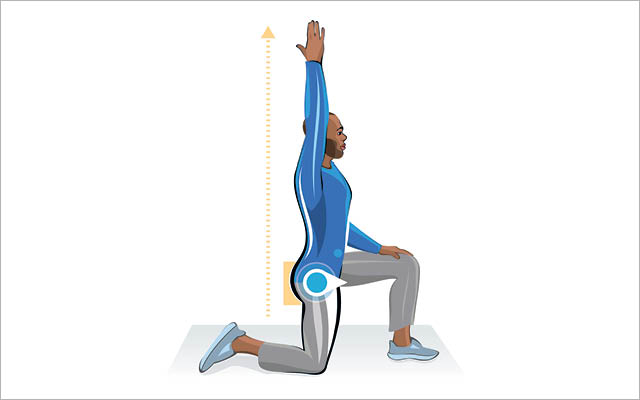
- Assume a low-lunge position, with your left foot and right knee on the ground, and both legs bent 90 degrees (use a cushion or folded yoga mat to support your knee, if needed). Rest your left hand on your front left thigh for support, if needed.
- Draw your bellybutton toward your spine to tilt your hips forward, and reach your right arm overhead. You should feel a gentle stretch in the front of your hip.
- Hold this position for 30 seconds before switching sides. Do two or three sets, two or three times per day.
Prone Press-Up
This exercise not only stretches the muscles in the front of your body — namely, the quads and hip flexors — but it’s also a healthy move for the lower back. “It helps to oppose all the flexed postures that we’re in for the majority of our day,” Lensing explains.
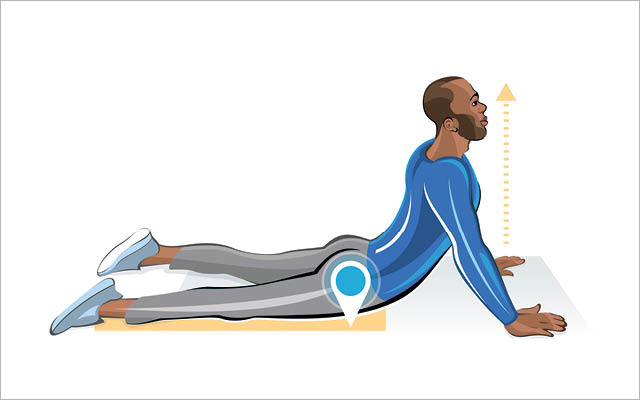
- Lie on your stomach with your hands on the floor at shoulder level.
- On a big exhale, press through your hands to lift your upper body off the floor until your arms are fully extended, keeping your hips and legs on the floor. Try to keep your glute muscles relaxed.
- Pause before bending at the elbows to lower your chest back down to the floor. Perform three sets of 10 reps, two or three times per day.
Supine Figure-Four Stretch
This move opens the hips and stretches the glutes, Lensing says.

- Lie on your back with your right knee bent, foot flat on the floor. Bring your left knee toward your chest and gently guide that ankle to rest on the right thigh.
- Slip both hands around the back of your right thigh and gently pull your leg
toward your chest without letting your torso or head rise from the floor. - Hold this position for 30 seconds, and then switch sides. Do three sets, two or three times per day.
Strength Moves
Side-Lying Hip Abduction With Band
This exercise strengthens your hip abductors, a group of muscles — specifically, the gluteus medius and minimus — that help keep you stable while walking and running.
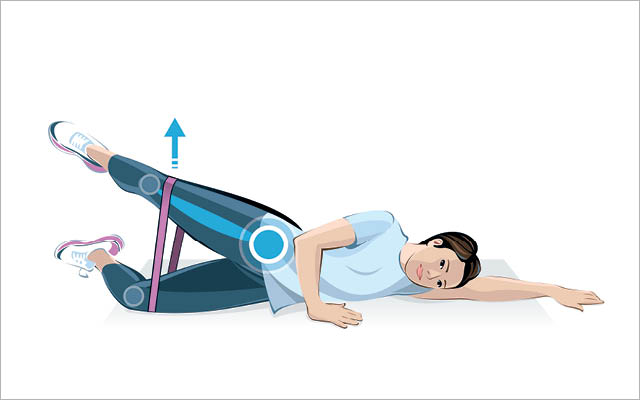
- Begin lying on your left side, legs bent, with a small resistance band around the lower thighs, above the knees.
- Roll your trunk forward and let your top leg fall behind your bottom leg. Let your head rest on your bottom arm. Place your opposite hand on the floor in front of your torso for support.
- To initiate the movement, lift your top leg until you feel a squeeze in your side-butt. Then lower your leg with control.
- Complete 20 reps before switching to your right side. Do two or three sets per side, two or three times per week.
- To make it easier, omit the resistance band. To make it harder, lift your upper body off the floor so you’re in a modified side-plank position.
Single-Leg Romanian Deadlift
This move gets you off the floor and uses your hips in a more functional position: standing on one leg. After all, walking, running, and even climbing stairs are technically single-leg movements. You should feel this exercise in the hamstrings and glutes, not in the lower back, Lensing says.
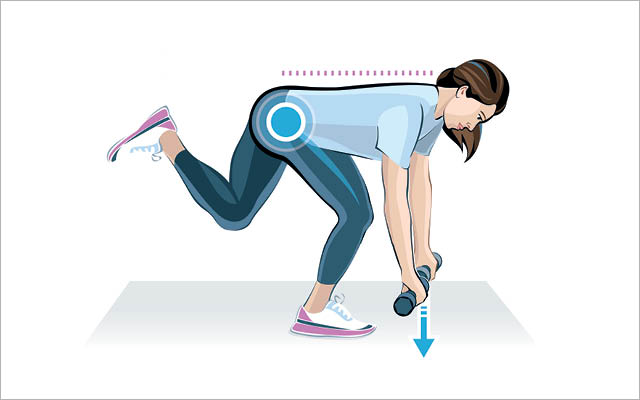
- Stand tall, holding a dumbbell in each hand in front of your thighs, palms facing toward you. Then shift your weight onto your right leg.
- With a gentle bend in your standing leg, lift your left foot a few inches off the floor behind you.
- Keeping your back flat, sit back into your hips and hinge forward to slowly lower the weights toward the floor. As you lower the weights, allow your elevated foot to lift toward the ceiling. Stop when you feel a slight pull in the hamstrings.
- Return to start. Perform two or three sets of 20 reps on each leg, two or three times per week.
Single-Leg Bridge With Knee to Chest
The single-leg bridge engages your gluteus maximus — a key muscle for keeping your hips healthy — while the knee-to-chest portion helps stretch the hip flexors at the same time, Lensing says.

- Lie on your back with knees bent and feet hip width apart on the floor.
- Bring your left knee to your chest and push into the floor with your right foot to raise your hips, squeezing your glutes as you do. Lift your hips as high as you can without arching your back.
- Keeping your knee pulled into your chest, lower your hips back down to the floor. Complete 10 to 20 reps before repeating on the other side. Do two or three sets per side, two or three times per week.
Get on the Floor
It’s never too late to get your hips back on track. A strength-and-mobility routine will help your hip muscles become active and mobile again, working to prevent injury and age-related pain later in life.
Another way to mobilize your hips is to vary how and where you sit every day, since this will load your joints in different ways, says Lynn Shuck, a Minnesota-based yoga instructor who teaches an alignment-focused style of yoga known as Eischens Yoga.
For instance, when you’re watching TV with your family, try to sit as close to the floor as you comfortably can. “The lower you go, the more you’re asking your muscles and joints to do,” Shuck explains.
If you can’t sit directly on the floor, grab a cushion, ottoman, or low chair, but try not to get too comfortable: “The comfier the chair, the longer you can sit there without moving.” (Struggle with getting up off the floor? Try the moves at “6 Exercises to Help You Get Down on the Floor — and Up Off the Floor – With Ease.”)
When you do sit on a chair or cushion, try to sit forward. This builds core strength. It also allows the spine to maintain its natural curves.
“Most of us slump back against the chair or couch. This tucks the pelvis, which is problematic for the back, the hips, and the pelvic floor,” she says. If sitting forward is uncomfortable, elevate your hips by adding blankets or cushions to your seat. “This will change the angle of the thighs in relation to your pelvis.”
You can also mobilize your hips by making a tweak to the way you stand. “We tend to stand with our weight forward on our feet, which also tends to tighten the hip flexors,” Shuck explains. Try shifting your weight back onto your heels when you stand — chances are you’ll feel your lower back and hip flexors relax when you do.
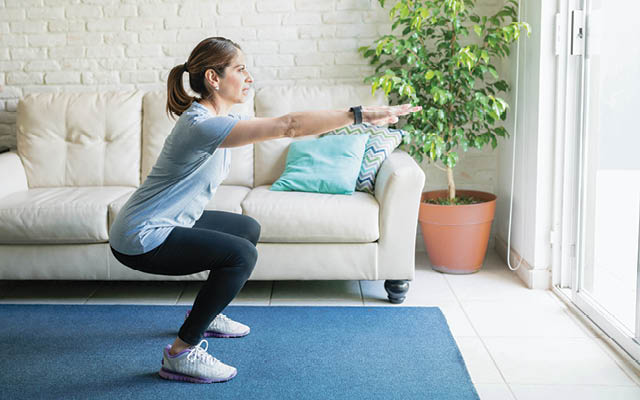
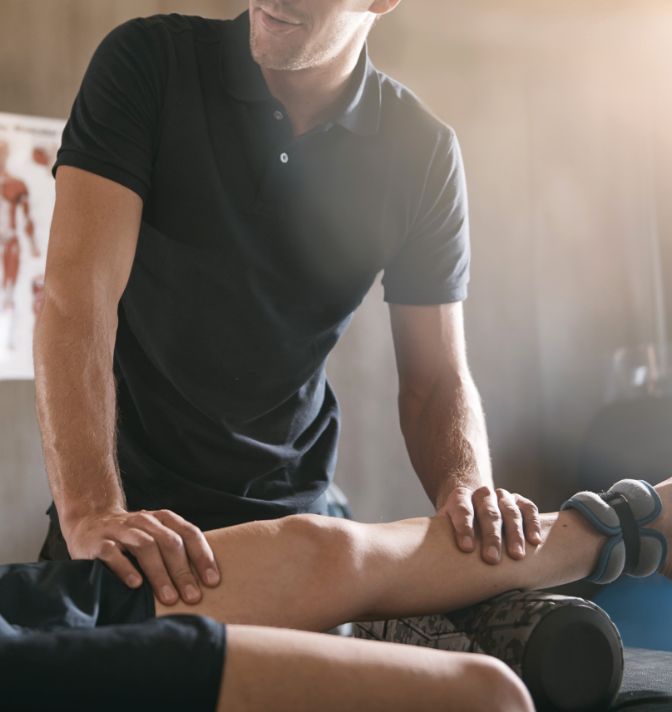
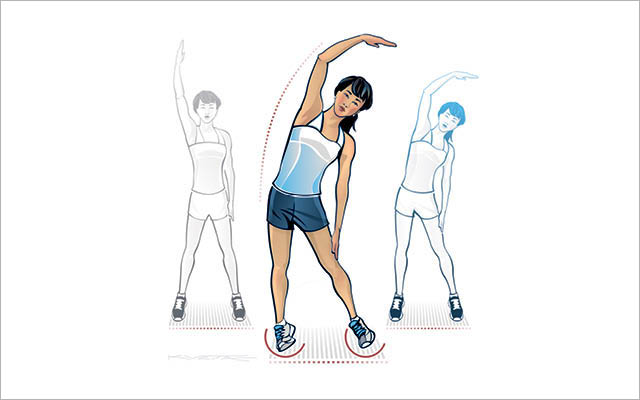
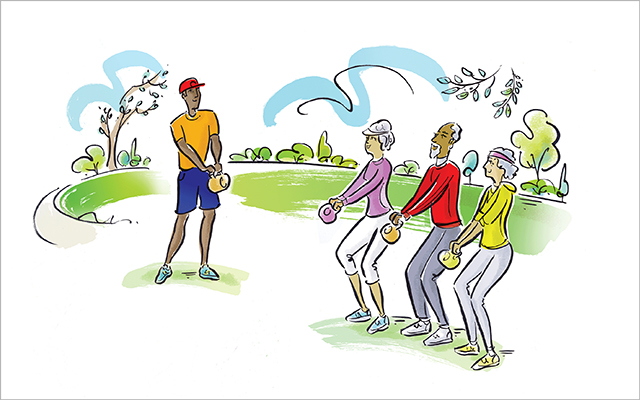

This Post Has 0 Comments